
Set (Seth, Suty, Sutekh) Son of Geb and Nut, Seth is a God of physical vigor and voracious sexual appetite in open conflict with social order and emotional bonds. While there are important contexts in which Seth’s activity is positive, most notably in his defense of the boat of Re against the attacks of Apophis, the great symbol of entropy, he is most well known as the murderer of his brother Osiris and for unsuccessfully vying for worldly sovereignty against Horus, the son of Isis and Osiris and the embodiment of legitimacy and civilization. In the conflict with Horus, Seth represents the principle that might makes right, as well as all the wild elements of human nature that resist civilization. Especially in his animal guises, or as the God of storms, Seth embodies the points at which nature itself comes into conflict with the human world, resisting domestication, or the points at which humans seek justification for their exploitation of nature, as in myths which sanctify the use of animal flesh in sacred contexts by identifying the animals in question with Seth or his followers. Seth’s positive aspects come to be expressed less and less over the course of Egyptian history, especially after the 20th dynasty, when a reaction against the foreign Hyksos dynasty who had taken Seth as their patron seems to have caused a precipitous decline in Seth’s cult. Whatever role contingent historical factors may have played in this fall from favor, it is also clearly to be attributed to the increasing centrality of the Osirian mythos in Egyptian culture, and perhaps as well as to the smaller accomodation afforded the wild, undisciplined aspects of life in an increasingly orderly and legalistic society. At his most positive, Seth represents vigor and strength, but in a form which would ruthlessly displace the weaker were it not kept in check. This force is constructive when channeled against either entropy itself (Apophis) or some other brute elemental force like the sea, subdued by Seth in a fragmentary myth. A candid recognition of Seth’s change in status can be seen in the so-called ‘Memphite Theology’, in which it is recounted that Geb, judging between Horus and Seth, initially resolves their conflict by dividing the nation, making Seth king of Upper (Southern) Egypt, “the place in which he was born,” and Horus king of Lower (Northern) Egypt, “the place in which his father was drowned,” but, as the text goes on to explain, “then it seemed wrong to Geb that the portion of Horus was like the portion of Seth. So Geb gave to Horus his [Horus’] inheritance, for he [Horus] is the son of the firstborn son,” (Lichtheim vol. 1, 52) thus awarding Horus sovereignty over the totality of a unified Egypt. Seth is a God to whom Egyptians, whether kings or commoners, had recourse, however, in war or in illness, life-or-death struggles where physical strength and combat prowess would be decisive. He occurs as well in certain images of balance and totality, such as in images of coronation or of the sma tawy, the ‘uniting of the (two) lands’, in which Seth represents Upper Egypt and Horus represents Lower Egypt, although there is a tendency later to replace Seth with Thothin these contexts as Seth falls into disfavor.
Seth is especially associated with a type of animal known in Egyptian as a sha, the identification of which remains controversial, and was probably unknown even in Egypt in the late period. If the sha was not a creature of fantasy, the most convincing identification of it is as a type of extinct wild pig, the so-called ‘Irish greyhound pig’, as argued by Newberry 1928. The sha-animal, which was also associated with the God Ash, has a body resembling a greyhound, with rectangular ears that stand up, a slightly drooping snout, and an upturned tail with a fork at the end (perhaps a stylized tuft). Detailed images show that the animal has lighter stripes on its back, the body being predominantly dark in color. Seth is depicted either as a sha or as a man with a sha‘s head. In addition, the was-scepter carried by so many Egyptian Gods appears to be a stylized sha; appropriately, the scepter’s name means ‘strength’. In later texts Seth is commonly characterized as a red ass or red dog, being associated with the color red from an early period. Red symbolizes in Egyptian thought the red land of the desert, as opposed to the black land rendered fertile by the Nile’s annual inundation, which gave its name to the Egyptian term for their own nation, Kemit, ‘the black land’. Seth and the sha-animal are strongly associated with the desert. Seth is also depicted frequently as a hippopotamus; he transforms into a hippopotamus at 13, 2-11 of the Conflict of Horus and Seth, although Horus is prevented by Isis from harpooning him. He is also associated with, although not necessarily depicted as, the crocodile, the oryx and the ostrich.
Darth Vader: The Dark Lord of the “Sith”, SETH was an alternate name for SET
Seth has Nephthys as his consort in addition to the foreign Goddesses Anat and Astarte, but has no divine offspring. Maga, a malevolent crocodile deity, is an exception, referred to often as ‘son of Seth’, but is not an object of cult. Seth has no posterity perhaps because he embodies a principle already taken to its extreme; because of his association with the unfertile ‘red land’ and with acts of violence; and also because he is associated with sexual activity expressing a purely physical urge, rather than as a bond which would be symbolically represented as fruitful. One might assume Seth’s lack of divine offspring to be attributable to the injury Horus inflicts upon Seth’s testicles complementary to that inflicted by Seth upon the eye of Horus; but Seth’s injury is healed just like that of Horus. In PT utterance 215, the king is urged to “spit on the face of Horus for him, that you may remove the injury which is on him”—saliva being thought of as a healing substance—”and pick up the testicles of Seth, that you may remove his [Seth’s] mutilation.” Injuries suffered by the Gods seem generally in Egyptian theology to afford an opportunity for mortals to be inserted into the mythic organization; accordingly we find the testicles of Seth represented in ritual by two sceptres, that is, as a form of divine power which can be symbolically appropriated by humans (Ramesseum Dramatic Papyrus 83-86 and scene 17, pl. 18; Griffiths 35).Seth is punished in a variety of ways for his act of violence against Osiris. He is forced to carry Osiris on his back, exalting the value of the mortal being, represented by Osiris, within the natural order which sweeps it remorselessly away: “Horus has laid hold of Seth and has set him under you [Osiris/the deceased] on your behalf so that he may lift you up and quake beneath you as the earth quakes, you being holier than he in your name of ‘Sacred Land’,” (PT utterance 356). Seth is sometimes represented as a ship when this is ritually enacted (Griffiths 11 n. 1, 48), which is significant since the cult statues of Egyptian Gods are always carried in boats when taken on procession. The forces embodied by Seth thus become the vehicle of divinities upholding a providential ordering of the cosmos. The punishments inflicted upon Seth in the Jumilhac Papyrus, by comparison, seem to legitimize the use by humans of various animal products such as leather. The violence inherent to these products, or to the consumption of meat, or to the obtaining of luxury products such as ostrich plumes, is theologically justified by symbolically identifying these animals with Seth. In this fashion, anything that mortals require (or are perceived to require) which incorporates an element of injustice or disorder in its production is referred back to the founding injustice of the mortal condition of which each individual, as mortal, is always already the victim.
An important incident in the Conflict of Horus and Seth is Seth’s sexual molestation of Horus. Seth attempts to argue on the basis of this incident that Horus is unsuited for the sovereignty, probably because it is supposed to imply that Horus is young and naïve, or not strong enough to have fought off Seth’s advances. Isis, however, by getting Horus to deposit some semen on lettuce in Seth’s garden (Seth, like Min, has an appetite for lettuce, an aphrodisiac in Egyptian lore) is able to summon the seed of Horus from within Seth’s body, making of him the passive partner as well. It comes forth from Seth’s forehead in the form of a golden solar disc (12, 12) which is appropriated by Thoth. Since the disc Thoth bears over his head is a lunar, rather than a solar disc, the incident perhaps accounts for the origin of the moon. Sometimes Thoth is himself said to have been conceived through this encounter (Griffiths 43). Another etiological divine injury occurs in the course of this myth, when the hands of Horus, in which he caught Seth’s semen, are cut off by Isis and thrown into the water, whereupon they transform into fish (CT spell 158/BD spell 113). The hands of Horus are replaced by Isis, the point being not the mutilation of the divine but the insertion of the human exploitation of a natural resource into a circuit of symbolic meaning.
In some contexts a reciprocity or rapprochement between Horus and Seth is particularly emphasized. For instance, in a spell (no. 25 in Borghouts) to conjure a particular type of demon, the magical potency invoked is characterized as “the protection [sau] of Horus that protects Seth and vice versa.” A spell against headache (no. 42 in Borghouts), which involves attaching a strip of fabric with seven knots in it to the patient’s big toe, says “The boy Horus spends the day lying on a cushion of nedj-fabric [the fabric which is knotted and attached to the patient’s toe]. His brother Seth kept watch over him, because he lay stretched out, his task being to keep the lower parts healthy.” References to Seth as the ‘brother’ of Horus do not contradict his status as his uncle, since ‘brother’ is simply sen, ‘two’, in Egyptian, and can refer to anyone who is in some sense the ‘double’ or complement of another, such as opponents in a lawsuit. In another spell (no. 115 in Borghouts) which is labelled a “protection of Horus,” (i.e. a protection furnished by Horus) the operator affirms that “Seth is on my right, Horus on my left,” while a “conjuration against a scorpion” (no. 117) says “Horus is behind me, Seth is next to my shoulder … Do not attack me! See, a great God [Seth] is the one who is at my side.” An exorcism (no. 119) includes the charm, “When Horus had looked behind him he found Seth following him and vice versa.” Sometimes Horus and Seth even appear fused, their two heads on one body, bearing the name Antywy (Antaios in Greek sources).An interesting spell (no. 102 in Borghouts) treats of an episode in which Seth has apparently been bitten or stung by something and requires the assistance of Horus, who is travelling with him. Echoing the famous myth involving Isis and Re (no. 84 in Borghouts), Horus states that Seth must tell him his (true) name in order to be healed. Seth offers a series of names to Horus, each of which Horus rejects as being not his true name. The names Seth offers for himself and which are rejected by Horus are: ‘yesterday, today, and tomorrow which has not yet come’; ‘a quiver full of arrows, a pot full of unrest’; ‘a man of an infinite number of cubits whose appearance is not known’; ‘a threshing floor as strong as bronze, which no cow has ever trodden’; ‘a jug of milk milked from the udder of Bastet’. The final name Seth offers, which is accepted and brings about his healing, is “a man of an infinite number of cubits, whose name is ‘Evil Day’. As for the day of giving birth and becoming pregnant—there is no giving of birth and sycamores will not bear figs.” This latter remark sounds very much like the entry for an unlucky day from a typical Egyptian calendar. According to this spell, therefore, while each of the other names Seth volunteers undoubtedly reflect valid aspects of his nature, the most adequate description of Seth is as an unlimited being who is a source of bad luck, specifically lack of fruitfulness.
A distinctive characteristic of Seth in addition to his strength and sexual appetite is his loud voice, which contrasts sharply with the Egyptian ideal of the person who is at once soft-spoken and laconic, exhibiting self-control and forethought. It is significant therefore that it is specifically Seth’s voice—perhaps a metaphor for thunder—that subdues the sea (spell no. 77 in Borghouts). The power of Seth’s voice is appropriated by the magician in a “conjuration against scorpions” (no. 120 in Borghouts) which states “The voice of the conjurer is loud while calling for the poison,” i.e., calling for the poison to exit the patient’s body, “like the voice of Seth while wrestling with the poison,” which, since the word for ‘poison’ and for ‘semen’ is the same in Egyptian, may be a reference to the Conflict myth, in which Seth is tricked into ingesting the semen of Horus. Another association of Seth’s which may relate to storms is iron, which was for the Egyptians paradigmatically meteoritic in origin. Hence in PT utterance 21, the iron of which the instrument used in the Opening of the Mouth ritual is said to be “the iron which issued from Seth,” and millennia later Plutarch reports the Egyptian tradition that the lodestone (magnetic oxide of iron) is “the bone of Horus” and iron is “the bone of Typhon,” i.e. Seth, in the Hellenistic syncretism (On Isis and Osiris 62, 376b).
In PT utterance 570 and 571, the deceased king affirms his immortality by stating “I escape my day of death just as Seth escaped his day of death,” repeating the formula with the units of “half-months of death,” “months of death,” and “year of death.” It seems in this fashion that Seth was susceptible to mortality like Osiris. Seth’s mortality is also enacted in the Pyramid Texts, however, in his identification with the sacrificial ox of PT utterance 580. The constellation Ursa Major was identified as the foreleg of Seth in the form of the sacrificial ox, and the adze used in the Opening of the Mouth ritual, the key moment in the ceremonies of resurrection, is also identified with this foreleg (te Velde 1967, 86-89).
The name of Seth (whose oldest form in Egyptian seems to have been closer to Sutekh or Setekh) may be related to words in Egyptian such as tekhi, ‘to be drunk’, tekhtekh, ‘disorder’, tesh, ‘to smash/crush’, while the Seth-animal is used as determiner for a variety of words having to do with misfortune, violence, confusion and storms (complete list in te Velde 1967, 22-23).
Further Info
Other Names: Seth, Sutekh
Patron of: winds, storms, chaos, evil, darkness, strength, war, conflict, Upper Egypt.
Appearance: A man with the head of a jackal-like animal. In depictions of his battle with Horus he is often shown as a black pig or hippopotamus. Sometimes he is shown as a crocodile, perhaps a combination of him and the original god of evil, Apep. He is also shown as a man with red hair and eyes, or wearing a red mantle, the Egyptians believing that bright red was a color of evil.
Description: In early times Set was worshiped as the god of wind and the desert storms, and prayed to that he would grant the strength of the storms to his followers. Although he was always a dark and moody god, he was believed to be the ally of his brother and sister, Osiris and Isis, the counterpart to his sister-wife Nephthys, and the defender of their father, Ra.But somewhere along the line the view of Set changed. He became a god of evil, in eternal conflict with the gods of light, and especially with Horus, the son of Osiris. Set became identified with his former enemy, the serpent Apep. By the XXVI Dynasty, Set was the major antagonist and embodiment of evil to the Egyptians. Why this change came about is unknown, but it is thought that some time after the unification of Egypt, the religion of Set fell into disfavor with the state religion, the worship of Ra and Osiris. It may be that there was open rebellion against the pharaoh Narmer (Menes) who unified Egypt under his rule, the rebellion failed and their beliefs were effectively quashed. Victors are known to rewrite history, it may be that they also rewrote the religion. It is an interesting idea to think that the struggle for the control of Egypt might have found its way into their core beliefs.
In the Legend of Osiris, Set kills Osiris and scatters his body, then claims the throne of the gods for his own. He is later struck down by Horus, the son of Osiris, who restores order to the world and sets up the pharaohs as the guardians of Maat. Set and Horus continue to battle for control of the world, setting up an epic conflict of good versus evil.
Worship: Not really worshiped after becoming a god of evil, but his religion was the major one for Upper Egypt until after the unification.
Variants:
Lord of Upper Egypt
An older form of Set in which he is seen to be a companion and ally to Osiris and Isis. He is depicted defending the Sun Boat from demons and revered as the patron of Upper Egypt. In this form Horus is his brother and is the patron of Lower Egypt.
Wiki Info
In Ancient Egyptian mythology, Set (also spelled Seth, Sheth, Sutekh, Setan or Seteh) is an ancient god, who was originally the god of the desert, storms, darkness, and chaos. In Ancient Greek, the god’s name is given as Σήθ (Seth).
Origins of name
The exact meaning of the name Set is unknown, but is usually considered to be either (one who) dazzles or pillar of stability, one connected to the desert, and the other tending to indicate the institution of monarchy. It is reconstructed to have been originally pronounced *Sūtaḫ based on the occurrence of his name in Egyptian hieroglyphics (swtḫ), and his later mention in the Coptic documents with the name Sēt. Set had a brother called Osiris and two sisters called Isis and Nephthys. His Mother was the sky goddess Nut and his father was the earth god Geb.
Set Animal
In art, Set was mostly depicted as a mysterious and unknown creature, referred to by Egyptologists as the Set animal or Typhonic beast, known as a Typhon, with a curved snout, square ears, forked tail, and canine body, or sometimes as a human with only the head of the Set animal. It has no complete resemblance to any known creature, although it does resemble a composite of an aardvark, a donkey, a jackal. It is also possible that Set is a representation of the giraffe due to the large flat-topped ‘horns’ which correspond to a giraffe’s ossicones. The main species of aardvark present in ancient Egypt additionally had a reddish appearance (due to thin fur, which shows the skin beneath it). In some descriptions he has the head of a greyhound. The earliest known representation of Set comes from a tomb dating to the Naqada I phase of the Predynastic Period (circa 4000 BC–3500 BC), and the Set-animal is even found on a mace-head of the Scorpion King, a Protodynastic ruler.
Was (“power”) scepters represent the Set-animal. Was scepters were carried by gods, pharaohs, and priests, as a symbol of power, and in later use, control over the force of chaos (Set). The head and forked tail of the Set-animal are clearly present. Was scepters are often depicted in paintings, drawings, and carvings of gods, and remnants of real Was scepters have been found constructed of faience or wood.
Conflict between Horus and Set
The myth of Set’s conflict with Horus, Osiris, and Isis appears in many Egyptian sources, including the Pyramid Texts, the Coffin Texts, the Shabaka Stone, inscriptions on the walls of the temple of Horus at Edfu, and various papyrus sources. The Chester Beatty Papyrus No. 1 contains the legend known as The Contention of Horus and Set. Classical authors also recorded the story, notably Plutarch’s De Iside et Osiride.
These myths generally portray Osiris as a wise lord, king, and bringer of civilization, happily married to his sister, Isis. Set was envious of his younger brother, and he killed and dismembered Osiris. Isis reassembled Osiris’ corpse and another god (in some myths Thoth and in others Anubis) embalmed him. As the archetypal mummy, Osiris reigned over the Afterworld as a king among deserving spirits of the dead.
Osiris’ son Horus was conceived by Isis with Osiris’ corpse, or in some versions, only with pieces of his corpse. Horus naturally became the enemy of Set, and many myths describe their conflicts.
The myth incorporated moral lessons for relationships between fathers and sons, older and younger brothers, and husbands and wives.
Set poked out Horus’s left eye so Horus cut off Set’s testicles, making him sometimes known as the god of infertility.
It has also been suggested that the myth may reflect historical events. According to the Shabaka Stone, Geb divided Egypt into two halves, giving Upper Egypt (the desert south) to Set and Lower Egypt (the region of the delta in the north) to Horus, in order to end their feud. However, according to the stone, in a later judgment Geb gave all Egypt to Horus. Interpreting this myth as a historical record would lead one to believe that Lower Egypt (Horus’ land) conquered Upper Egypt (Set’s land); but, in fact Upper Egypt conquered Lower Egypt. So the myth cannot be simply interpreted. Several theories exist to explain the discrepancy. For instance, since both Horus and Set were worshiped in Upper Egypt prior to unification, perhaps the myth reflects a struggle within Upper Egypt prior to unification, in which a Horus-worshiping group subjugated a Set-worshiping group. What is known is that during the Second Dynasty, there was a period in which the King Peribsen’s name or Serekh — which had been surmounted by a Horus falcon in the First Dynasty — was for a time surmounted by a Set animal, suggesting some kind of religious struggle. It was ended at the end of the Dynasty by Khasekhemwy, who surmounted his Serekh with both a falcon of Horus and a Set animal, indicating some kind of compromise had been reached.
Regardless, once the two lands were united, Set and Horus were often shown together crowning the new pharaohs, as a symbol of their power over both Lower and Upper Egypt. Queens of the 1st Dynasty bore the title “She Who Sees Horus and Set.” The Pyramid Texts present the pharaoh as a fusion of the two deities. Evidently, pharaohs believed that they balanced and reconciled competing cosmic principles. Eventually the dual-god Horus-Set appeared, combining features of both deities (as was common in Egyptian theology, the most familiar example being Amun-Re).
Later Egyptians interpreted the myth of the conflict between Set and Osiris/Horus as an analogy for the struggle between the desert (represented by Set) and the fertilizing floods of the Nile (Osiris/Horus).
Savior of Ra
As the Ogdoad system became more assimilated with the Ennead one, as a result of creeping increase of the identification of Atum as Ra, itself a result of the joining of Upper and Lower Egypt, Set’s position in this became considered. With Horus as Ra’s heir on Earth, Set, previously the chief god, for Lower Egypt, required an appropriate role as well, and so was identified as Ra’s main hero, who fought Apep each night, during Ra’s journey (as sun god) across the underworld.
He was thus often depicted standing on the prow of Ra’s night barque spearing Apep in the form of a serpent, turtle, or other dangerous water animals. Surprisingly, in some Late Period representations, such as in the Persian Period temple at Hibis in the Khargah Oasis, Set was represented in this role with a falcon’s head, taking on the guise of Horus, despite the fact that Set was usually considered in quite a different position with regard to heroism.
This assimilation also led to Anubis being displaced, in areas where he was worshipped, as ruler of the underworld, with his situation being explained by his being the son of Osiris. As Isis represented life, Anubis’ mother was identified instead as Nephthys. This led to an explanation in which Nephthys, frustrated by Set’s lack of sexual interest in her, disguised herself as Isis, but failed to gain Set’s attention because he was infertile. Osiris mistook Nephthys for Isis and they had conceived Anubis resulting in Anubis’ birth. In some later texts, after Set lost the connection to the desert, and thus infertility, Anubis was identified as Seth’s son, as Set is Nephthys’ husband.
In the mythology, Set has a great many wives, including some foreign Goddesses, and several children. Some of the most notable wives (beyond Nephthys/Nebet Het) are Neith (with whom he is said to have fathered Sobek), Amtcheret (by whom he is said to have fathered Upuat – though Upuat is also said to be a son of Anubis or Osiris), Tawaret, Hetepsabet (one of the Hours, a feminine was-beast headed goddess who is variously described as wife or daughter of Set), and the two Canaanite deities Anat and Astarte, both of whom are equally skilled in love and war – two things which Set himself was famous for.
Set in the Second Intermediate and Ramesside Periods
During the Second Intermediate Period, a group of Asiatic foreign chiefs known as the Hyksos (literally, “rulers of foreigns lands”) gained the rulership of Egypt, and ruled the Nile Delta, from Avaris. They chose Set, originally Lower Egypt’s chief god, the god of foreigners and the god they found most similar to their own chief god, as their patron, and so Set became worshiped as the chief god once again.
The Hyksos King Apophis is recorded as worshiping Set in a monolatric way: “[He] chose for his Lord the god Seth. He didn’t worship any other deity in the whole land except Seth.” Jan Assmann argues that because the Ancient Egyptians could never conceive of a “lonely” god lacking personality, Seth the desert god, who was worshiped exclusively, represented a manifestation of evil.
When Ahmose I overthrew the Hyksos and expelled them from Egypt, Egyptian attitudes towards Asiatic foreigners became xenophobic, and royal propaganda discredited the period of Hyksos rule. Nonetheless, the Set cult at Avaris flourished, and the Egyptian garrison of Ahmose stationed there became part of the priesthood of Set at Avaris.
The founder of the nineteenth dynasty, Ramesses I came from a military family from Avaris with strong ties to the priesthood of Set. Several of the Ramesside kings were named for Set, most notably Seti I (literally, “man of Set”) and Setnakht (literally, “Set is strong”). In addition, one of the garrisons of Ramesses II held Set as its patron deity, and Ramesses II erected the so-called Four Hundred Years’ Stele at Pi-Ramesses, commemorating the 400 year anniversary of the Set cult in the Delta.
Set also became associated with foreign gods during the New Kingdom, particularly in the Delta. Set was also identified by the Egyptians with the Hittite deity Teshub, who was a storm god like Set.
Demonization of Set
Set was one of the earliest deities, with a strong following in Upper Egypt. Originally highly regarded throughout Egypt as the god of the desert, a political faction inspired an initial disparaging of Set’s name and reputation. Egypt was originally split into two kingdoms: Upper ruled by Horus (and later Ra), Lower by Set. Set’s followers resisted a unification of the Upper and Lower kingdoms of Egypt by the followers of Horus/Ra (with the followers of Osiris and Isis). This political split was echoed in the Osiris & Isis myth, and subsequent battle with Horus. The followers of Horus thus denigrated Set as chaotic and evil. By the 22nd Dynasty, Set was equated with his old enemy, Apep, and his images on temples were replaced with those of Sobek or Thoth. Most modern popular misconceptions of Set come from Plutarch’s secondary source interpretations of Set (via the writings of Herodotus et al.), long after Set’s demonization (circa 100 A.D., Roman Period in Egypt).
Set was further demonized immediately after the Hyksos Period. The evidence from the Nineteenth Dynasty proves that this is a more complex picture.
Most scholars date the demonization of Set to after Egypt’s conquest by the Persian ruler Cambyses II. Set, who had traditionally been the god of foreigners, thus also became associated with foreign oppressors, including the Achaemenid Persians, Ptolemaic dynasty, and Romans. Indeed, it was during the time that Set was particularly vilified, and his defeat by Horus widely celebrated.
Set’s negative aspects were emphasized during this period. Set was the killer of Osiris in the Myth of Osiris and Isis, having hacked Osiris’ body into pieces and dispersed it so that he could not be resurrected. If Set’s ears are fins, as some have interpreted, the head of the Set-animal resembles the Oxyrhynchus fish, and so it was said that as a final precaution, an Oxyrhynchus fish ate Osiris’ penis. In addition, Set was often depicted as one of the creatures that the Egyptians most feared, crocodiles, and hippopotamodes.
The Greeks later linked Set with Typhon because both were evil forces, storm deities, and sons of the Earth that attacked the main gods.
Nevertheless, throughout this period, in some outlying regions of Egypt Set was still regarded as the heroic chief deity.
Temples
Set was worshipped at the temples of Ombos (Nubt near Naqada) and Ombos (Nubt near Kom Ombo), at Oxyrhynchus in upper Egypt, and also in part of the Fayyum area.
More specifically, Set was worshipped in the relatively large metropolitan (yet provincial) locale of Sepermeru, especially during the Rammeside Period. There, Seth was honored with an important temple called the “House of Seth, Lord of Sepermeru.” One of the epithets of this town was “gateway to the desert,” which fits well with Set’s role as a deity of the frontier regions of ancient Egypt. At Sepermeru, Set’s temple-enclosure included a small secondary shrine called “The House of Seth, Powerful-Is-His-Mighty-Arm,” and Ramesses II himself built (or modified) a second land-owning temple for Nephthys, called “The House of Nephthys of Ramesses-Meriamun.”. There is no question, however, that the two temples of Seth and Nephthys in Sepermeru were under separate administration, each with its own holdings and prophets. Moreover, another moderately sized temple of Seth is noted for the nearby town of Pi-Wayna. The close association of Seth temples with temples of Nephthys in key outskirt-towns of this milieu is also reflected in the likelihood that there existed another “House of Seth” and another “House of Nephthys” in the town of Su, at the entrance to the Fayyum.
Perhaps most intriguing in terms of the pre-Dynasty XX connections between temples of Set and nearby temples of his consort Nephthys is the evidence of Papyrus Bologna, which preserves a most irritable complaint lodged by one Pra’em-hab, Prophet of the “House of Seth” in the now-lost town of Punodjem (“The Sweet Place”). In the text of Papyrus Bologna, the harried Pra’em-hab laments undue taxation for his own temple (The House of Seth) and goes on to lament that he is also saddled with responsibility for: “the ship, and I am likewise also responsible for the House of Nephthys, along with the remaining heap of district temples”.
It is unfortunate, perhaps, that we have no means of knowing the particular theologies of the closely connected Set and Nephthys temples in these districts—it would be interesting to learn, for example, the religious tone of temples of Nephthys located in such proximity to those of Seth, especially given the seemingly contrary Osirian loyalties of Seth’s consort-goddess. When, by Dynasty XX, the “demonization” of Seth was ostensibly inaugurated, Seth was either eradicated or increasingly pushed to the outskirts, Nephthys flourished as part of the usual Osirian pantheon throughout Egypt, even obtaining a Late Period status as tutelary goddess of her own Nome (UU Nome VII, “Hwt-Sekhem”/Diospolis Parva) and as the chief goddess of the Mansion of the Sistrum in that district.
Yet, it is perhaps most telling that Seth’s cultus persisted with astonishing potency even into the latter days of ancient Egyptian religion, in outlying (but important) places like Kharga, Dakhlah, Deir el-Hagar, Mut, Kellis, etc. Indeed, in these places, Seth was considered “Lord of the Oasis/Town” and Nephthys was likewise venerated as “Mistress of the Oasis” at Seth’s side, in his temples (esp. the dedication of a Nephthys-cult statue). Meanwhile, Nephthys was also venerated as “Mistress” in the Osirian temples of these districts, as part of the specifically Osirian college. It would appear that the ancient Egyptians in these locales had little problem with the paradoxical dualities inherent in venerating Seth and Nephthys as juxtaposed against Osiris, Isis & Nephthys. Further study of the enormously important role of Seth in ancient Egyptian religion (particularly after Dynasty XX) is imperative.
The power of Seth’s cult in the mighty (yet outlying) city of Avaris from the Second Intermediate Period through the Ramesside Period cannot be denied. There he reigned supreme as a deity both at odds and in league with threatening foreign powers, and in this case, his chief consort-goddesses were the Phoenicians Anat and Astarte, with Nephthys merely one of the harem.
Contemporary Occult Symbols Connected with SET
Historical Gallery
Hollywood Depictions of SET
After Jack’s symbolic transition from OSIRIS to SET he wears a ‘red’ jacket for the remainder of the film,
he also speaks with Grady (an earlier incarnation of SET) inside a ‘red’ bathroom, who prompts him to murder his family.
VIEW MORE HOLLYWOOD DEPICTIONS OF SET
First Published: Dec 10, 2011 – Last Updated: Dec 15, 2012

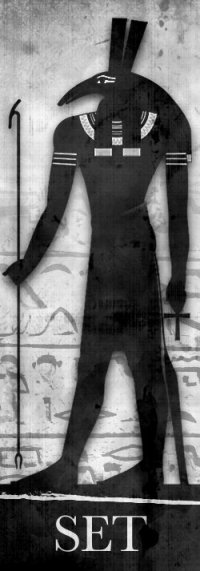


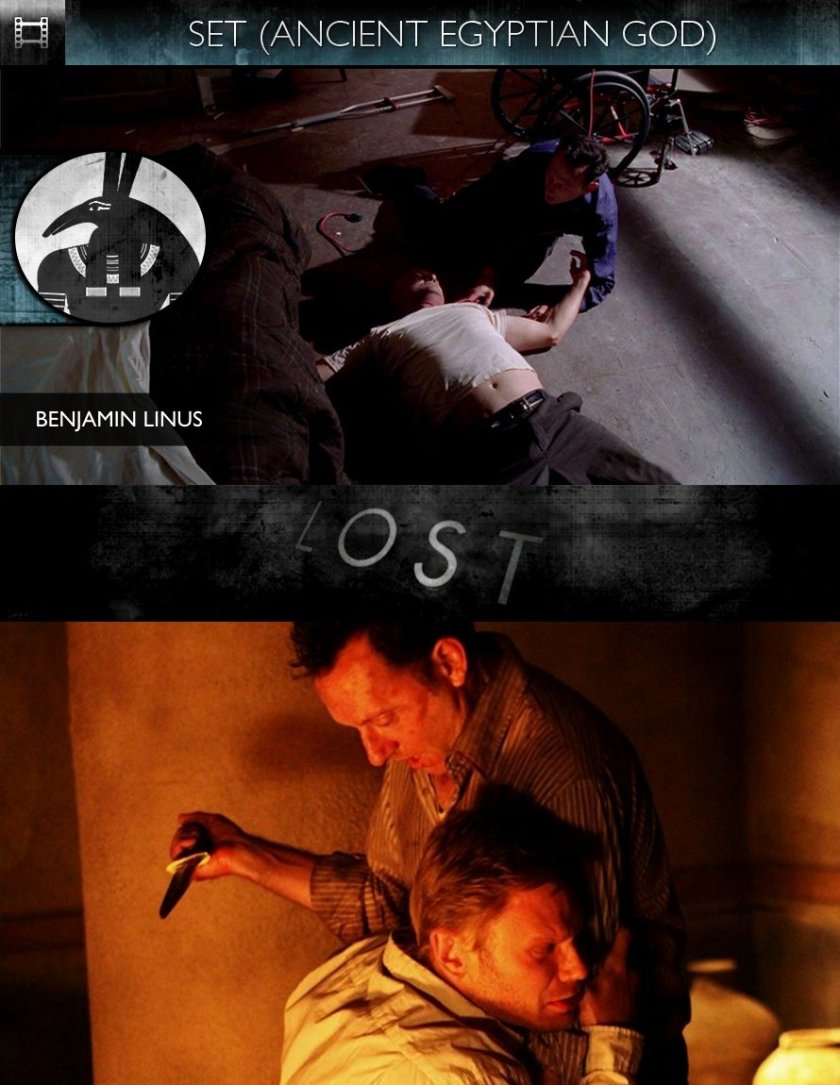
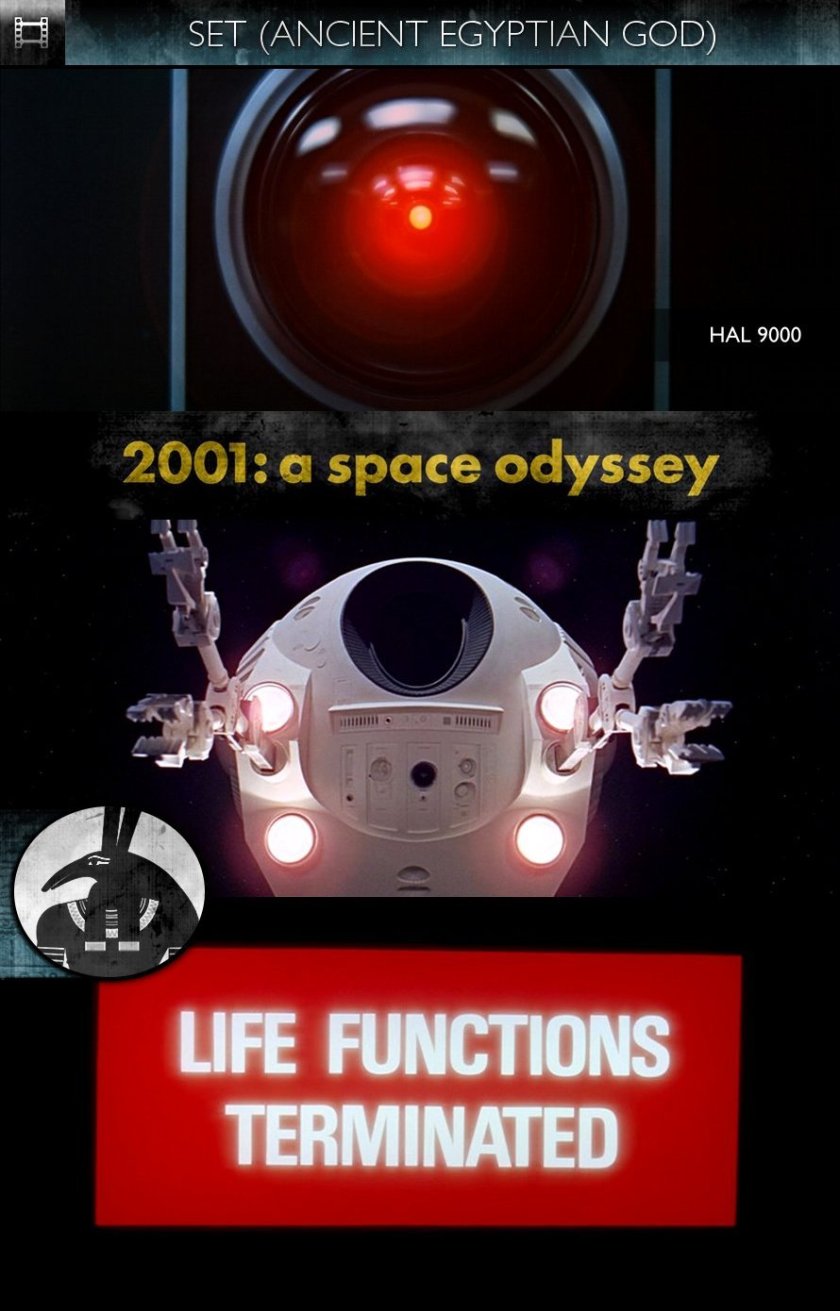

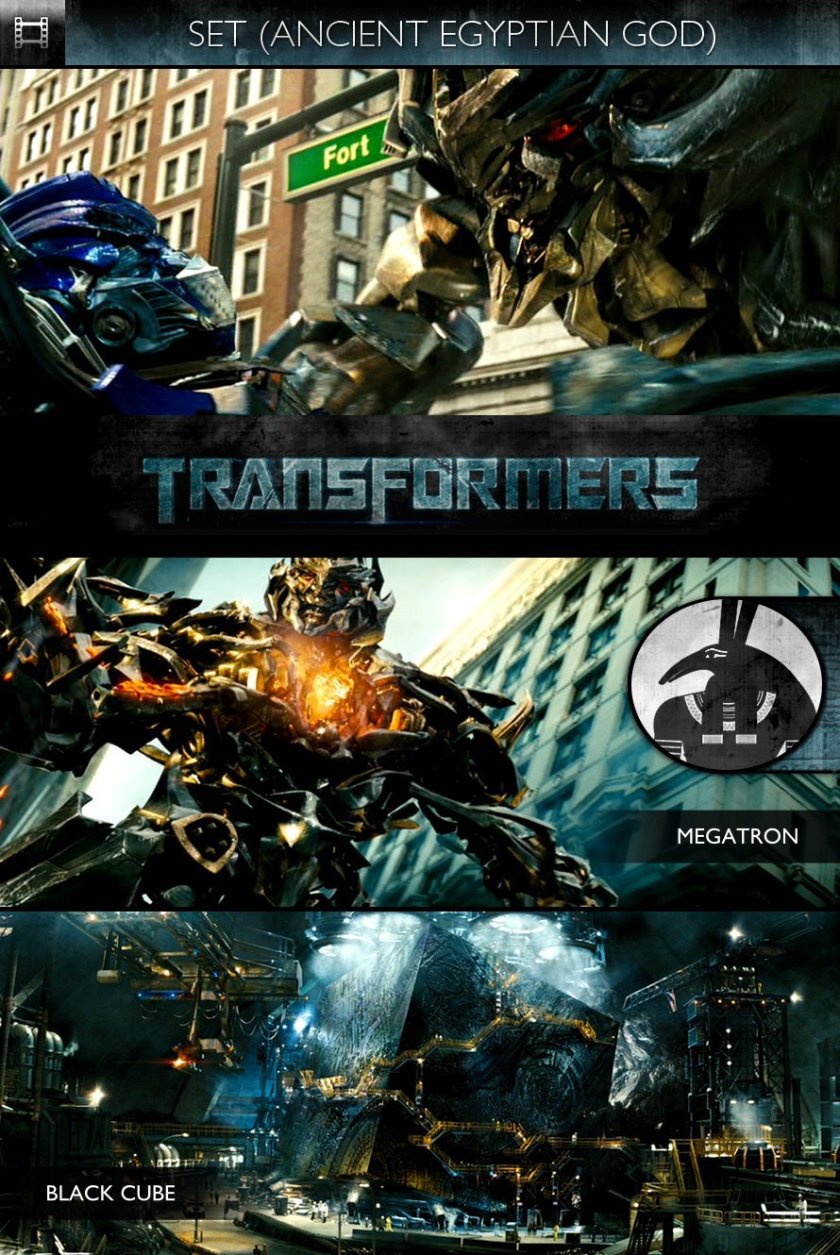


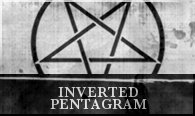

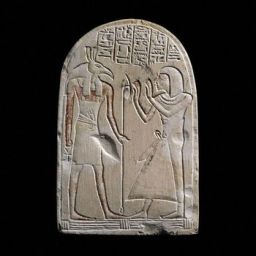
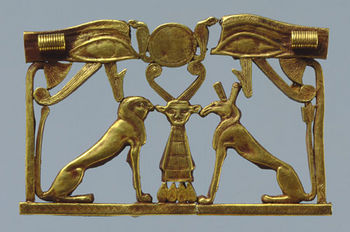

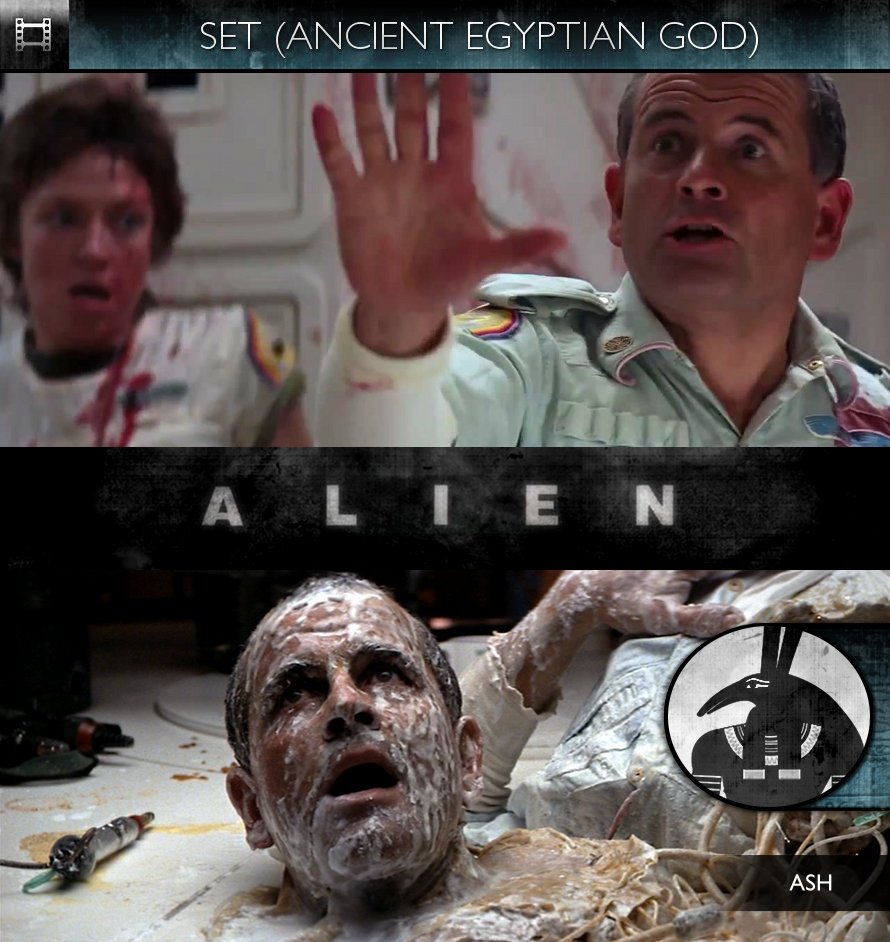
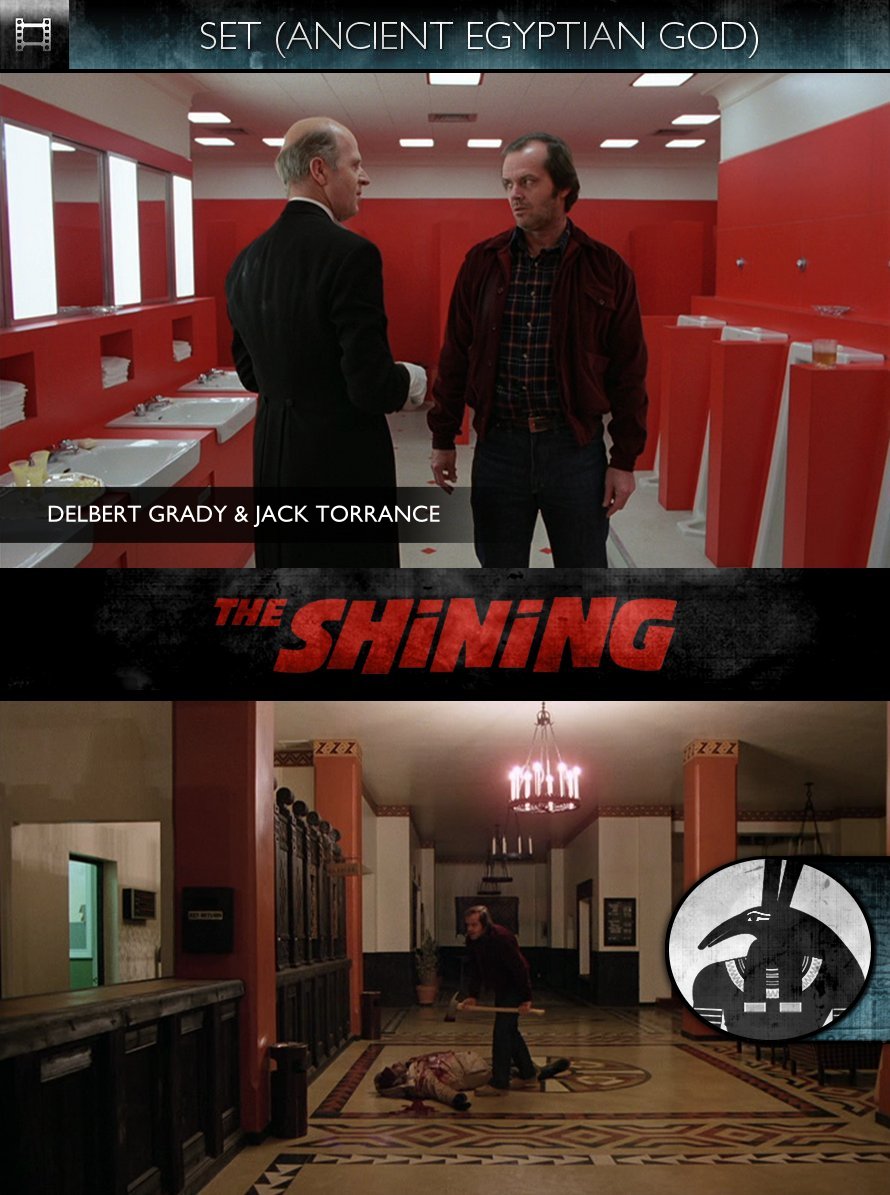


You must be logged in to post a comment.